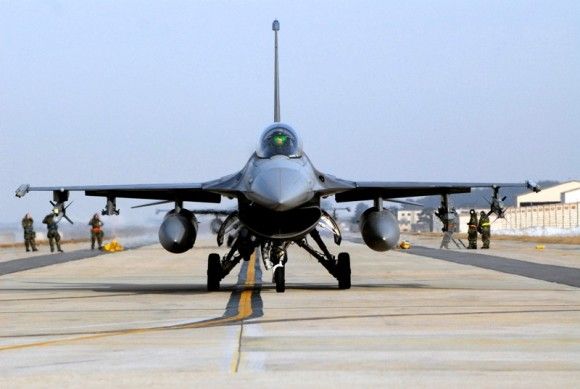Pilica VSHORAD System Contract Concluded
Polish Army will acquire combined Pilica missile-artillery air defence systems. A relevant agreement, signed in the presence of the Polish Minister of Defence, assumes that equipment for six battery-sized units is to be procured, for almost 746.16 million zlotys.
This is one of the most important procurement programmes for the Polish Army (...) I would like to thank the President of the ZM Tarnów company, for facing this challenge. The employment rate at the facility went up, which is the best proof that cooperation between the industry and the Ministry of Defence may have an effective impact within the socio-economic context.
A relevant agreement was signed in presence of the Polish Minister of Defence, Antoni Macierewicz, at the ZM Tarnów facility. As a result of the aforesaid event, the Polish Army is going to receive combined missile-artillery anti-aircraft systems, developed and manufactured by the Tarnów-based company which belongs to the Polish Armaments Group (PGZ). The agreement has been signed by the following persons: Arkadiusz Siwko, President of the Management Board of the PGZ Company; Adam Lesiński, Member of the Board of the PGZ Company; Deputy Chief of the Armament Inspectorate, Col. Piotr Imański; President of the Management Board of the ZM Tarnów company, Henryk Łabędź; Member of the Board of the ZM Tarnów company, Łukasz Komendera; Member of the Board of the ZM Tarnów company, Rafał Kowalczyk; Member of the Board of the PIT-RADWAR company, Janusz Wieczorek; Member of the Board of the PCO Company, Stanisław Natkański; and Member of the Board of the PCO company, Irena Rdzanek.
The contract assumes that 6 complete systems would be procured. Each of the systems includes six firing units with towing vehicles, command station, radar, two transport vehicles and two ammunition carriers. The procurement, in line with the agreement, is to take place in the period between 2019 and 2022. The deliveries will be implemented by a consortium, led by PGZ. ZM Tarnów is the technological leader and the main supplier, while the consortium itself additionally involves the PIT-RADWAR and PCO companies. Net value of the deal is defined as PLN 746.16 million. The contract also precisely defines the conditions of handing off, regarding the logistics packages containing the repair and maintenance kits, and the training package.

Pilica battery consists of six systems, each of those systems being fitted with two 23 mm cannons and two Grom/Piorun anti-aircraft missile launchers, allowing the operator to act against airborne targets at distances of up to 5 kilometres, with the use of missiles. The systems have also been fitted with its own optronic sensor, featuring a thermal vision camera, TV camera and a laser rangefinder. Pilica may be used autonomously then, but it is also tailored to become a part of a multi-layered integrated air defence system, in the VSHORAD role.
Pilica combined missile-artillery anti-aircraft system is one of the most important short range defence solutions, a foundation, a base for the Polish anti-aircraft defences.
The system’s purpose is to protect important areas or facilities (e.g. airbases), within the framework of the national air defence suite. In the standard mode of operation, Pilica system is controlled via a wire-communications suite (based on optical fibres, at ranges of up to 5 kilometres) as well as via radio, with the use of a computerized command station, constituting a component of the battery. The station uses the data coming from radars, also from the Soła early warning 3D radar.
The event of signing the agreement, concerning the procurement of the “Pilica” system means that we have finalized one of the key initiatives, the goal of which was to increase the level of national security. Polish Armaments Group provides a guarantee to the Polish Ministry of Defence, that it will create all of the system’s components autonomously, which is also important, from the point of view of the Poland’s defence capabilities. PGZ will be enhancing, developing and upgrading the “Pilica” system in an ongoing manner, so that the Armed Forces have equipment placed within their inventory, which is becoming more and more advanced.
As the Polish Ministry of Defence informs, Pilica, within the Polish Army, is to become the basic air defence system for the air defence branch of the Armed Forces. The system in question is to be suitable for defending the air bases, complementing the kill zones of the short and medium range anti-aircraft missiles, at low altitudes. Thanks to the common data-link, the system will also provide relaying capabilities, when it comes to the information received from other elements of the IADS.
Tarnów-based facility will be manufacturing this system, because the said facility is best prepared for this task. We deeply believe that Tarnów will be able to perform the work correctly, and the time to perform the agreement-related work is very limited. The contract is flexible, as now, we expect that the contractor develops the executive project, to which a new work-group, established by the head of the Armament Inspectorate, would refer, presenting its remarks. On the basis of the executive project, the first prototype Pilica is to be created, conforming with the military requirements, and series production process would start only after this step is completed.
After the Poprad and Pilica systems contracts were signed, and once the Grom-M/Piorun agreements are concluded (planned to happen by the end of this year) modernization of the VSHORAD solutions used by the Polish Army is going to enter a phase, in which the work on the said systems would be completed by the domestic defence industry.












